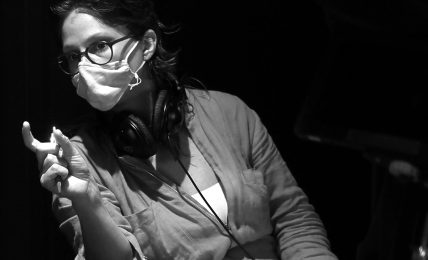Digital America interviewed Nathan Harper in April of 2024 on his work Flower Burial.
:::
Digital America: Flower Burial (2024) is an experimental sound project constructed from a single sample of a voicemail received from medical debt collectors. This piece exposes the robotic messages received from United States healthcare debt collectors and compares it to another extreme—Neanderthals burial rituals. What are you hoping to reveal as the voice is transformed throughout the piece?
Nathan Harper: The voice on the other end of the line is not a voice at all. It is merely an uncanny simulacrum of human speech designed to detach me from the situation. It insists I do not need to take things personally or feel anything about the situation. It is rational, calculated, and unavoidable. My feelings are lost on the machine as it has no ability (or desire) to understand me. In Flower Burial, I refuse these conditions in favor of a personal and painful reshaping of the sound. With each edit I made, it moved further away from voice, the resulting noises are piercing and relentless but somehow more bearable and honest to me than the false humanity of before. At least this noise does not pretend to possess humanity and empathy; instead, it is unabashedly cold and indifferent. Yet It can be faced and overcome, and there is something on the other side.
Dig A: I was struck by how you took a relatively simple and familiar concept and created movement after movement of complexity. It links to a complex metaphor; that the way we have rituals surrounding death and injuries is by spamming voicemails to notify the surplus amount of money you’re being charged. As an artist how do you see your role in not exploring sound, but also making art about social issues?
NH: I feel it is important to make work about the immediate issues of my life, even those that appear mundane and impossible to romanticize, such as medical debts. It is easier to romanticize the archaic struggles of the past or the unimaginable struggles of the future but we don’t afford the same kind of dignity to the everyday horrors we face. With Flower Burial, I wanted to take a bird’s eye view of a simple and fundamental human experience: pain. Pain is arguably one of the most universal components of myths and rituals about self-actualisation, but we have no such ceremonies for the new pains of banality, so we do not heal from them mentally. As an artist, I wish to advocate for new remedies while calling attention to the systems inflicting mundane suffering on us.
Dig A: Your work “The Hedgehog’s Dilemma” is based on the metaphor of hedgehogs being unable to gather closely at risk of hurting each other with their sharp spines, bringing our pandemic-induced isolation into sharp focus while tying into the inherent difficulty of forming close relationships, which I found to be extremely interesting. Does your background in internet culture influence your approach to creative work in these pieces? Would you say you are influenced by your surroundings in life when creating work?
NH: Yes, definitely! I have been part of my fair share of niche online communities and still am really. From my obsessions with fantasy RPG games, online myths, metalcore, and deathcore music, I spent my developmental years online, and it has profoundly impacted how I relate to art and the world at large. One day, people will research the digital communities I grew up in and cultivated a sense of self in, like Myspace, Deviantart, and Death Metal forums, and that’s fascinating to me because they felt outside of time at the time. It was as if what we were doing and making was at the end of time, and we were expecting nothing to come after.

The Hedgehog’s Dilemma
Dig A: In your artist statement you say “artificial human’s speech with a dispassionate yet confrontational voice is the basic building block used to build a harsh monolithic wall of digital noise that periodically breaks down into swaths of ambient soundscapes.” When experiencing Flower Burial, I could feel the dispassionate and roughness of the voice that created this distant feeling to humanity. How did you intend for the audience to feel during Flower Burial, and could you share your emotions and thoughts when creating it?
NH: I used to receive these calls very frequently, and I got to a point where I could recognize them as soon as I picked up the phone. There was a rhythm to the robot voice that was burned into my head. I got to the point where I would hang up as soon as I realized what it was. I wanted to get away from that sound as quickly as possible. Returning to these voicemails for this project was very therapeutic for me. It allowed me to stay with these sounds I had avoided and renegotiate their meaning. I hope a listener finds mindfulness and stillness on the other side of the wall of noise, almost like a ritual of resilience. Not unlike our Neanderthal cousins, who navigated their mortality in an indifferent landscape using such delicate tools as flowers, we, too, must devise new methods of making peace with our new world.
Dig A: Can you talk about what you are working on currently?
NH: Yes, I would love to! Focusing on sound itself is a relatively new direction for me. I have always worked with sound but seen it as supplementary to video or other visual elements that I have considered to be the “primary” work. Lately, sound by itself has taken center stage for me, so most of my newer projects are fully sound-based or at least have a heavy sound element to them. I am in the early stages of a collaborative project with a composer and a guitarist that will explore some aspects of metal music and the mythology within those communities. I am also starting another raw, harsh noise project that centers around an extreme dietary cult and its connection to an American fast food chain. Both works are very new, so I don’t have much to say about them at this point, but I am very excited for them both.
:::
Check out Nathan Harper’s work Flower Burial.
:::

Nathan Harper is an interdisciplinary artist and Professor of Digital Art and Creative Technology
at Florida SouthWestern State College. He received his MFA from The University of North
Texas with a concentration in New Media.



